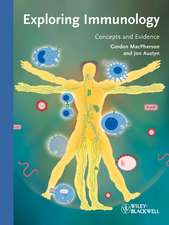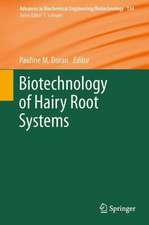The Air Spora: A manual for catching and identifying airborne biological particles
Autor Maureen E. Lacey, Jonathan S. Westen Limba Engleză Paperback – 19 oct 2006
"I recommend this book to those actively running or thinking of running a pollen and spore trapping program. It will also be of value to doctors, allergists, and those teaching the basics of palynology, wishing to include a lecture or two on air spora."
David M. Jarzen, Florida Museum of Natural History
In: The Newsletter of the American Association Of Stratigraphic Palynologists, 2007(40:2)
Preț: 1133.86 lei
Preț vechi: 1491.92 lei
-24% Nou
Puncte Express: 1701
Preț estimativ în valută:
216.97€ • 226.99$ • 180.23£
216.97€ • 226.99$ • 180.23£
Carte tipărită la comandă
Livrare economică 29 martie-04 aprilie
Preluare comenzi: 021 569.72.76
Specificații
ISBN-13: 9780387302522
ISBN-10: 0387302522
Pagini: 156
Ilustrații: XVI, 156 p.
Dimensiuni: 193 x 260 x 13 mm
Greutate: 0.36 kg
Ediția:2007
Editura: Springer Us
Colecția Springer
Locul publicării:New York, NY, United States
ISBN-10: 0387302522
Pagini: 156
Ilustrații: XVI, 156 p.
Dimensiuni: 193 x 260 x 13 mm
Greutate: 0.36 kg
Ediția:2007
Editura: Springer Us
Colecția Springer
Locul publicării:New York, NY, United States
Public țintă
ResearchCuprins
Chapter 1 Introduction to Aerobiology 1. What is aerobiology 2. The Air Spora 3. What is in the air 4. Early history of aerobiology 5. Aerobiology as a discipline 6. Aerobiology in action Chapter 2 The Aerobiology Pathway 1. Introduction 2. Take-off (Release) 3. Dispersal 4. Deposition - sedimentation and impaction 5. Impact 6. Interpreting spore trap data 7. Dispersal by rain splash and aerosol Chapter 3 Air Sampling Techniques 1. Introduction 2. Passive traps 3. Cascade impactor 4. Andersen sampler 5. Whirling arm trap 6. Burkard trap 7. Cyclone and minature cyclone samplers 8. Virtual impactors and liquid impingers 9. Filters Chapter 4 Using a Burkard Trap 1. Introduction 2. Siting the trap 3. Running the trap Chapter 5 Using a microscope 1. Introduction 2. Microscope structures 3. Using a microscope 4. Measuring and calibration Chapter 6 Pollen and spore counts 1. Introduction 2. Counting pollens and spores from a Burkard trap 3. Counting pollen and spores from a whirling arm trap Chapter 7 Identification 1. Introduction 2. Particle types 3. Useful references 4. Paintings –x1000 Appendix Glossary References Index Chapter 1 Introduction to Aerobiology 1. What is aerobiology 2. The Air Spora 3. What is in the air 4. Early history of aerobiology 5. Aerobiology as a discipline 6. Aerobiology in action Chapter 2 The Aerobiology Pathway 1. Introduction 2. Take-off (Release) 3. Dispersal 4. Deposition - sedimentation and impaction 5. Impact 6. Interpreting spore trap data 7. Dispersal by rain splash and aerosol Chapter 3 Air Sampling Techniques 1. Introduction 2. Passive traps 3. Cascade impactor 4. Andersen sampler 5. Whirling arm trap 6. Burkard trap 7. Cyclone and minaturecyclone samplers 8. Virtual impactors and liquid impingers 9. Filters Chapter 4 Using a Burkard Trap 1. Introduction 2. Siting the trap 3. Running the trap Chapter 5 Using a microscope 1. Introduction 2. Microscope structures 3. Using a microscope 4. Measuring and calibration Chapter 6 Pollen and spore counts 1. Introduction 2. Counting pollens and spores from a Burkard trap 3. Counting pollen and spores from a whirling arm trap Chapter 7 Identification 1. Introduction 2. Particle types 3. Useful references 4. Paint
Recenzii
From the reviews:
‘A book on general aerobiology with an emphasis towards fungal spores and pollen that will interest both the specialist and the non-specialist. The illustrations are great’ W.D. Griffiths, Airborne Matters, Dunstable, Beds, UK
"The book adds a novel and important value to aerobiology. ‘The Air Spora’ is a well written step-by-step guide to key techniques for trapping, identifying and quantifying airborne biological particles. The book enables precise identification of particles largely by superb colour paintings. In my opinion the book will remain for decades a reference source for most institutions concerned with aerobiology. In conclusion, ‘The Air Spora’ is a high-quality book which could be recommended" (Jacek Dutkiewicz, Annals of Agricultural and Environmental Medicine, Issue 13, 2006)
"This book draws together the different approaches and techniques, used in aerobiology in a very informative and useful way. The authors have produced a text which will become a standard reference in aerobiological teaching and research. The glossary contains many aerobiological terms which should be useful for the beginner. Given the subject areas covered and illustrations it is likely that this book will appeal to a wide range of nonspecialists readers as well as aerobiological connoisseurs." (Roy Kennedy, Plant Pathology, Issue 58, 2007)
"I recommend this book to those actively running or thinking of running a pollen and spore trapping program. It will also be of value to doctors, allergists, and those teaching the basics of palynology, wishing to include a lecture or two on air spora." (David M. Jarzen, Florida Museum of Natural History In: The Newsletter of the American Association Of Stratigraphic Palynologists, 2007)
"‘The Air Spora’ … is an illustrated guide for trapping and quantifying airborne fungus spores, pollen and other bioparticles. … The illustrations,microphotographs and colour paintings are very pleasing and are of high quality. The book is paper bound with an attractive laminated cover page containing paintings of biological particles which gives the book a most pleasing appearance. … This is a well prepared manual and should be possessed by all aerobiologists. It is a ‘must’ for youngsters who choose to pursue research in aerobiology." (B. P. R. Vittal, Indian Journal of Aerobiology, Vol. 19 (2), 2006)
‘A book on general aerobiology with an emphasis towards fungal spores and pollen that will interest both the specialist and the non-specialist. The illustrations are great’ W.D. Griffiths, Airborne Matters, Dunstable, Beds, UK
"The book adds a novel and important value to aerobiology. ‘The Air Spora’ is a well written step-by-step guide to key techniques for trapping, identifying and quantifying airborne biological particles. The book enables precise identification of particles largely by superb colour paintings. In my opinion the book will remain for decades a reference source for most institutions concerned with aerobiology. In conclusion, ‘The Air Spora’ is a high-quality book which could be recommended" (Jacek Dutkiewicz, Annals of Agricultural and Environmental Medicine, Issue 13, 2006)
"This book draws together the different approaches and techniques, used in aerobiology in a very informative and useful way. The authors have produced a text which will become a standard reference in aerobiological teaching and research. The glossary contains many aerobiological terms which should be useful for the beginner. Given the subject areas covered and illustrations it is likely that this book will appeal to a wide range of nonspecialists readers as well as aerobiological connoisseurs." (Roy Kennedy, Plant Pathology, Issue 58, 2007)
"I recommend this book to those actively running or thinking of running a pollen and spore trapping program. It will also be of value to doctors, allergists, and those teaching the basics of palynology, wishing to include a lecture or two on air spora." (David M. Jarzen, Florida Museum of Natural History In: The Newsletter of the American Association Of Stratigraphic Palynologists, 2007)
"‘The Air Spora’ … is an illustrated guide for trapping and quantifying airborne fungus spores, pollen and other bioparticles. … The illustrations,microphotographs and colour paintings are very pleasing and are of high quality. The book is paper bound with an attractive laminated cover page containing paintings of biological particles which gives the book a most pleasing appearance. … This is a well prepared manual and should be possessed by all aerobiologists. It is a ‘must’ for youngsters who choose to pursue research in aerobiology." (B. P. R. Vittal, Indian Journal of Aerobiology, Vol. 19 (2), 2006)
Caracteristici
Comprehensive review of the history, equipment and techniques used in aerobiology Over 340 colour paintings of airborne particles to unified scale for help in identification Illustrated laboratory guide for trapping and counting of airborne particles No other book of its type Accessible to and understandable by non-specialists Comprehensive guide to aerobiology Includes supplementary material: sn.pub/extras









